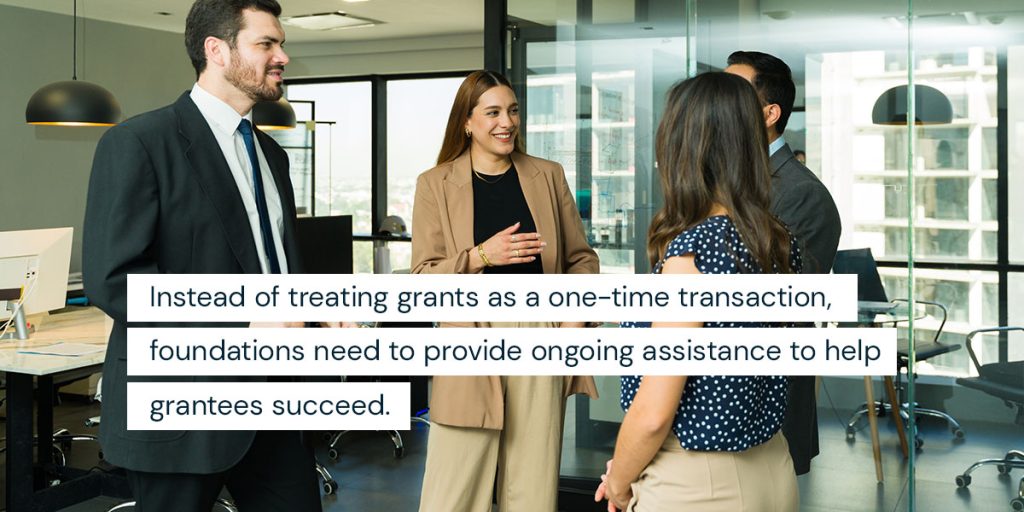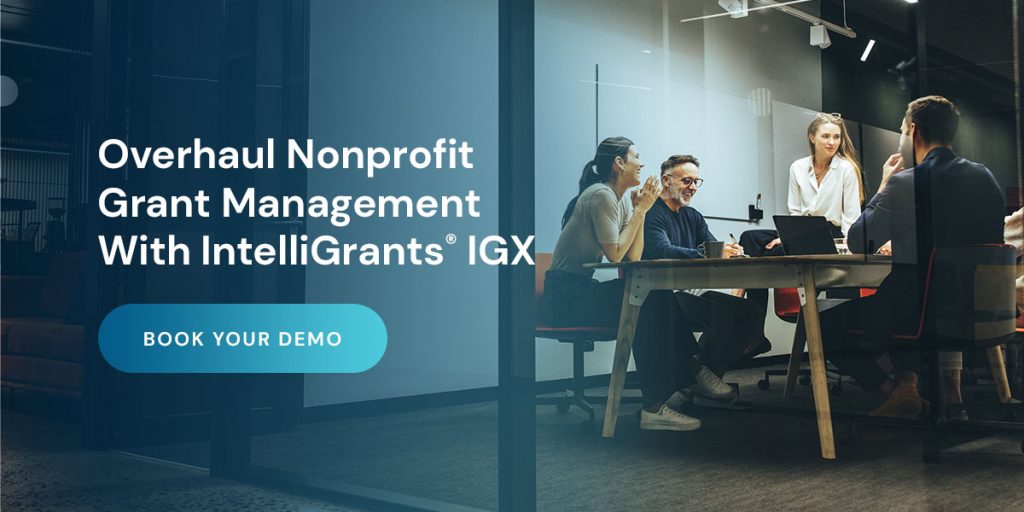DAFs let donors recommend grants to nonprofits. Community foundations manage the funds, while donors advise on what they would like the funds to go toward. DAFs give donors more control over funds without losing tax advantages.

Community foundations are critical to helping communities meet their needs. Funds given to local businesses, support structures and families raise standards of living and access to essential services. Without a streamlined way to award and track funds, nonprofits struggle to ensure money is distributed fairly and effectively.
Effective grant management helps foundations maximize their resources and impact. With the right tools and strategies, you can ensure your nonprofit has the best chance of supporting those who need it most.
Table of contents:
Community foundations are the backbone of local philanthropy. They build grants designed to support nonprofits and economic development. With their funding, communities can address their most important needs. Private foundations usually receive their financing from one source. In comparison, nonprofits pool funding from people, families and businesses. This collective funding model allows them to fund lots of projects and goals.
Essentially, community foundations act as financial managers for charitable donations. They manage assets and distribute grants to eligible nonprofits and parties. Funding comes from:
After receiving their funding, community foundations must create and award grants using the contributions. Charitable foundations are a go-between for donations and local projects. They review the applications and award grants based on the proposals they see and the funding they have. Each grant program is designed to meet different goals.
The main grant types for nonprofits include:
DAFs let donors recommend grants to nonprofits. Community foundations manage the funds, while donors advise on what they would like the funds to go toward. DAFs give donors more control over funds without losing tax advantages.
Foundations award these grants through an application and review process. Nonprofits will apply based on grant requirements. They’re more intensely evaluated than other funding methods.
Grant funds traditionally run out. Endowments are invested, generating returns that sustain programs long-term. Foundations use endowments to provide priority areas with long-term financing, creating more stable support.
Community foundations must work to ensure their grants are put to good use. However, managing different backing sources and grants complicates the work. Struggles with funding and inefficiency are common, your foundation might see more risks in stability and compliance. Nonprofits must understand these challenges and work to address them quickly to avoid issues.
Community foundations see high volumes of grant applications. So much funding requires a fair and trustworthy process, but it’s slow.
If reports are generated manually, staff must compile the data, slowing down the process and increasing errors. Without enough staff or support, foundations relying on manual processes face severe delays.

Application processing can be extremely time-consuming, especially without effective software. Manual reviews delay funding distribution and lead to compliance mistakes. All this manual information exists outside a centralized system. It becomes easy for managers to lose track of applications, budgets and reports — your foundation might see duplicate data and inconsistencies.
Clear communication is key to successful grant management, but nonprofits might have difficulty balancing necessary communication. Unstructured reporting systems leave donors and stakeholders out of the loop, which affects trust and transparency. If grant guidelines aren’t laid out clearly, grantees may fail to meet requirements, affecting local financing.
Foundations must have good internal and external communication to succeed. Groups that lack standardized evaluation and review criteria can seem inconsistent in their grant awarding. Community foundations must invest in clear communication and processes to protect trust between them and their communities.
Community foundations must meet government laws and industry regulations to maintain community accreditation standards and tax-exempt status. They need to use funds correctly, document information and comply with restrictions. Meeting all these standards while monitoring funding is time-consuming. If foundations lack centralized data and automated tools, they can violate compliance requirements. This might leave them without support, or they could face penalties and lose community standing.
Funding is a critical part of a nonprofit organization. It’s what allows them to support local initiatives. However, nonprofits are facing a donation shortage. In 2024, 51% of community foundations reported decreased gift-giving rates. As gifting rates drop, nonprofits must explore new sources of funding and work to keep local projects in motion.
If you’re looking to improve your foundation’s impact, you need to invest in efficiency and accuracy. Look to grant management software and strategic improvements to reduce administrative hurdles and improve compliance. With automation and better connectivity, you can create stronger relationships and support community success.
Use these strategies to help your nonprofit build a better grant management approach.
The modern world is a digital one. Complicated regulations and dozens of forms mean manual processes no longer get the job done. Grant management software is the solution. A well-designed, personalized platform can streamline every stage of the grant life cycle. With the right software, community foundations can benefit from:
The application and review process can take up considerable time. It’s essential to choose the best candidates for grants, but foundations want to avoid delays. Overhaul outdated processes to create a system that’s efficient and transparent. Focus on standardization and automation to make management better.
Your application process must be clear, firm and efficient. Minimize confusion with straightforward application requirements. Applicants should readily understand funding priorities and reporting expectations. Once you have clear application guidelines, you need to set firm deadlines. Predictable review cycles make it easier for applicants to apply on time and avoid last-minute rushes. Finally, use automated tools to prescreen eligibility, reducing process times and decreasing administrative work for your team.
Next, take a second look at your review process. Reevaluate it the same way you did the application steps. Is there a clear and fair scoring criteria? Is the review panel diverse and experienced? Use grant management software to automate review assignments for easier processing. Emphasize transparency and structure in each process to keep grant management consistent.
Your nonprofit depends on communication to keep everyone informed and effective. Grantees need to understand their responsibilities, while donors have to know how their finances are being put to use. Use technology to improve communication and trust between stakeholders.
For grantees, make sure they understand:
Keep donors in the loop by sharing regular updates and hosting events. Community foundations should give out regular updates on progress, fund allocation and success stories. Donor dashboards make monitoring financing simple. When donors can see the outcome of their donations, it builds their confidence in your foundation. Consider hosting webinars, site visits or appreciation events to show off grantee work further.
Compliance is another focus area for community foundations. Combine management software with research to confirm your foundation is following all relevant regulations. Grantees must go through a vetting process to ensure they can responsibly use funds. Grantmakers should visit sites and review progress reports to keep all grantees on track. If there’s fund misuse, you need protocols to handle it. Audits and corrective active plans can make the process more transparent and honest.
When it comes to grants, organizations must be able to measure funding impact. Nonprofits need accurate, regular data collection to see how their backing is helping the community. A quality grant management platform can simplify this process through trend analysis, impact measurement and reporting.

Good grant management goes beyond efficiency. It’s about making the best impact on the community. Doing truly transformative work takes strategy and connection. Your foundation must rearrange itself around improvement — whether you’re looking to see better outcomes or build stronger grantor-grantee relationships.
Try these tips to create meaningful change and improve grant management.
Every foundation needs a strong grantmaking strategy. If your nonprofit lacks a framework, it’s harder to keep teams on track. Create a strategy that puts your community first by:

Grantmakers and grantees need to work together to create change. Instead of treating grants as a one-time transaction, foundations need to provide ongoing assistance to help grantees succeed. Make sure you’re offering to help grantees where you have the resources.
Additionally, encourage grantees to check in with teams regularly. They should discuss their challenges and get advice on their work. Grantees should feel supported throughout the funding cycle to create a more effective effort.
When grantees meet their goals, show off their achievements. Announcements and events build confidence in grantees, improving your relationship with them.
While you need to celebrate success and communicate challenges, it’s harder to know when there’s success without data. Community foundations should track key performance indicators (KPIs). Use this data to power different strategies and track grantee progress and applications Your data-tracking strategy should include:
Combine data collection with feedback to get a comprehensive picture of your funding success. Data can show you quantitative results, but surveys give you the reasoning behind that data. Use surveys to get the opinions of applicants, grantees, donors and stakeholders.
Ask them what they like about your foundation’s processes and what challenges they faced. Are donors happy with funding priorities? Review surveys and adjust the organization’s approach to make the grantmaking process better for applicants and the community.

The community relies on your foundation to deliver funds to groups that are going to help the people. Community foundations must keep their operation transparent, compliant and effective to ensure funding gets where it needs to go. With the right tools, your organization can deliver greater impact without overworking your team.
IntelliGrants® IGX is a cutting-edge grant management solution designed to help nonprofits. Our software automates workflows, enhances reporting accuracy and simplifies administrative work. We offer built-in compliance tracking, real-time data and configurable workflows. IntelliGrants IGX empowers foundations to focus on their mission.
See how IntelliGrants IGX can optimize your grantmaking process. Book your demo today!